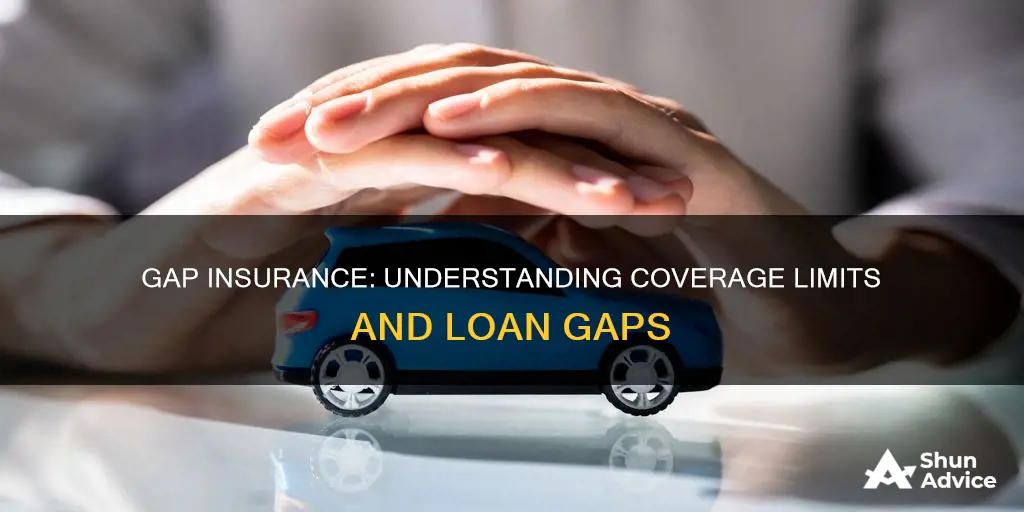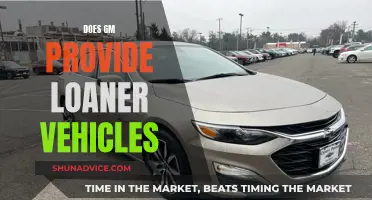
Gap insurance is a type of auto insurance coverage that pays the difference between the insured current value of a vehicle and the balance of a loan or lease. It is called loan/lease coverage or loan/lease protection by some insurers. Gap insurance is optional and only pays out after a total loss covered by collision or comprehensive insurance. It does not cover additional charges related to your loan, such as finance or excess mileage charges, nor does it cover engine failure or other repairs. In some cases, the GAP benefit may not waive the entire outstanding balance, and you may be required to pay the remaining amount.
| Characteristics | Values |
|---|---|
| What is GAP insurance? | Optional auto insurance coverage that applies if your car is stolen or deemed a total loss. |
| When is GAP insurance needed? | When the loan amount is more than the vehicle's worth. |
| What does GAP insurance cover? | The difference between the insured current value of a vehicle and the balance of a loan or lease. |
| What does GAP insurance not cover? | Additional charges related to your loan, such as finance or excess mileage charges, injuries, death, funeral costs, engine failure, or other repairs. |
| When does GAP insurance pay? | After a total loss covered by your collision or comprehensive insurance. |
| What if there is an outstanding balance after GAP insurance has been paid? | Contact your finance company to inquire about the outstanding balance. |
What You'll Learn
- Gap insurance covers the difference between the value of a totaled vehicle and what you owe on a loan/lease
- Gap insurance is optional and covers the gap between what a car is worth and what is owed on a loan
- Without gap insurance, drivers are responsible for paying the remaining loan balance on a vehicle they can no longer drive
- Gap insurance doesn't cover engine failure, transmission failure, or other mechanical repairs
- Gap insurance doesn't cover additional charges like finance or excess mileage fees

Gap insurance covers the difference between the value of a totaled vehicle and what you owe on a loan/lease
Gap insurance is an optional type of auto insurance coverage that applies if your car is stolen or deemed a total loss. It covers the difference between the value of a totaled vehicle and what you owe on a loan or lease. This type of insurance is especially important if you owe more on your car loan than the car is worth. In the event of a total loss, gap insurance can help protect you from being unable to cover the remaining loan amount.
When a vehicle is declared a total loss or is stolen and not recovered, the car owner will receive a payout from their comprehensive or collision coverage. This payout is the actual cash value (ACV) of the vehicle, minus the deductible. If the payout is insufficient to cover the remaining loan amount, gap insurance can step in to cover the difference. This is especially important if the car has depreciated in value since the loan was taken out.
It is important to note that gap insurance does not cover additional charges related to the loan, such as finance or excess mileage charges. It also does not cover engine failure, transmission failure, or other mechanical repairs. Gap insurance is solely intended to cover the financial gap between the value of the vehicle and the outstanding loan amount in the event of a total loss.
When considering whether to purchase gap insurance, it is important to weigh the potential benefits against the cost of the coverage. Gap insurance may be a good option if there is a significant difference between the value of the vehicle and the amount owed on the loan, or if a smaller down payment was made on the vehicle. By having gap insurance, car owners can have peace of mind knowing that they will not be left with a large outstanding loan balance in the event of a total loss or theft of their vehicle.
Freedom Loan in Ohio: What You Need to Know
You may want to see also

Gap insurance is optional and covers the gap between what a car is worth and what is owed on a loan
Gap insurance is an optional form of auto insurance that covers the difference between the amount paid out by comprehensive or collision coverage and the balance left on a vehicle loan or lease. In other words, it covers the gap between what a car is worth and what is owed on a loan. This type of insurance is particularly useful when a vehicle is deemed a total loss or is stolen and not recovered.
When a car is declared a total loss, the insurer will pay the actual cash value (ACV) of the vehicle, minus the deductible, to the lender. If the loan amount is more than the value of the car, gap insurance can be used to pay the difference. For example, if you owe $25,000 on your loan and your car is only worth $20,000, gap insurance will cover the $5,000 gap, minus your deductible. This protects the driver from having to pay out of pocket to make up the shortfall.
Gap insurance is especially relevant for drivers who owe more on their car loan than the car is worth, also known as being ""upside down" on the loan. This can occur due to factors such as a small down payment, a long loan or lease period, or rapid depreciation of the vehicle's value. By covering the gap between the insurance payout and the loan amount, gap insurance helps to bridge the financial gap for drivers in these situations.
It is important to note that gap insurance does not cover additional charges related to the loan, such as finance or excess mileage fees. It also does not cover engine failure, transmission issues, or other mechanical repairs. The coverage is specifically designed to protect against financial loss in the event of a total loss or theft of the vehicle. Therefore, gap insurance is optional but valuable coverage for drivers who want protection against the potential financial consequences of a total loss or stolen vehicle when they owe more than the car's value.
Gabbana's Fashionable Friendship with Melania Trump
You may want to see also

Without gap insurance, drivers are responsible for paying the remaining loan balance on a vehicle they can no longer drive
If a driver totals their car or their car is stolen, their insurance provider will pay them the actual cash value (ACV) of the vehicle, which is the amount the car was worth immediately before the incident. This ACV is calculated by the insurer and is based on the car's resale value, not its replacement value. If the driver's loan balance exceeds the ACV payout, they will be responsible for paying the remaining balance of the loan themselves.
Gap insurance is an optional insurance coverage that can be purchased to cover this remaining balance. It is called loan/lease coverage or loan/lease protection by some insurers. It is only worth buying gap insurance if the driver owes more on their car than it is worth. If the driver's car is damaged but repairable, gap insurance will not cover the cost of repairs.
Gap insurance is also useful for protecting against depreciation. Once a car is purchased, its value starts to decrease, sometimes significantly. This depreciation can leave a gap between what is owed on the loan and the car's value. For example, if a driver finances $30,000 for a new car, after a few years, the car may only be worth $20,000, but the driver still owes $25,000 on their loan, representing a $5,000 gap. In this case, without gap insurance, the driver would be responsible for paying the $5,000 gap themselves.
It is important to note that gap insurance does not cover additional charges related to a loan, such as finance or excess mileage charges, credit insurance, overdue payments, or late fees. It also does not cover the cost of a new replacement vehicle, only the outstanding balance on the loan.
Freddie Mac Loan Lookup: What You Need to Know
You may want to see also

Gap insurance doesn't cover engine failure, transmission failure, or other mechanical repairs
Gap insurance is a type of auto insurance that you can purchase to protect yourself financially in case your car is stolen or deemed a total loss. It covers the difference between the value of a totaled vehicle and what you owe on a loan or lease. This type of insurance is especially useful if you didn't make a down payment or if you chose a long loan term, as it can help bridge the gap between the claim payout amount and the balance still due on your car loan.
However, it's important to note that gap insurance doesn't cover engine failure, transmission failure, or other mechanical repairs. It also doesn't cover injuries or property damage resulting from an accident. Mechanical issues on their own are not covered by car insurance or gap insurance. Gap insurance only pays out after a total loss covered by collision or comprehensive insurance, such as an auto accident or theft of your vehicle.
Additionally, gap insurance may not cover all charges related to your loan, such as finance or excess mileage charges, credit insurance, extended warranties, lease penalties, or overdue payments and late fees. It's important to carefully review the terms of your car loan and the specific gap insurance policy to understand what is and isn't covered.
To qualify for gap insurance, you typically must already have comprehensive and collision coverage on your policy. The cost of gap insurance can vary depending on factors such as your state, driving record, age, and the value of your vehicle.
Freddie Mac: Minimum Loan Amounts and Their Impact
You may want to see also

Gap insurance doesn't cover additional charges like finance or excess mileage fees
Gap insurance is an optional auto insurance coverage that applies if your car is stolen or deemed a total loss. It pays the difference between the value of a totaled vehicle and what you owe on a loan or lease. This type of insurance is useful when the loan amount is more than the vehicle is worth, as it covers the difference. However, it is important to note that gap insurance does not cover additional charges like finance or excess mileage fees.
When you file a qualifying claim, your comprehensive or collision coverage will pay the actual cash value (ACV) of your vehicle, minus your deductible. Gap insurance then comes into play and pays the remaining balance on your loan or lease. This ensures that you are not left with a financial burden if your car is stolen or totaled.
It is worth noting that gap insurance does not cover all expenses related to your vehicle. While it can provide financial protection in the event of a total loss or theft, there are certain additional charges that it does not cover. These include finance charges, excess mileage fees, down payments for a new car, credit insurance charges, carry-over balances from previous loans or leases, extended warranties, lease penalties for high mileage or excessive use, and overdue payments or late fees on your car loan or lease.
Gap insurance is designed to protect you from financial loss in the event of a total loss or theft of your vehicle. However, it is important to carefully review the terms and conditions of your specific gap insurance policy to understand exactly what is and is not covered. Additionally, to qualify for gap insurance, you typically must have comprehensive and collision coverage on your policy.
In summary, while gap insurance can provide valuable financial protection by covering the difference between the value of your totaled vehicle and what you owe on a loan or lease, it does not cover additional charges like finance or excess mileage fees. These types of fees are separate from the gap between the value of your vehicle and your loan or lease balance, and thus fall outside the scope of gap insurance coverage.
Who Owns My Loan? Freddie Mac and Your Mortgage
You may want to see also
Frequently asked questions
Gap insurance is an optional auto insurance coverage that applies if your car is stolen or deemed a total loss. It covers the difference between the insured current value of a vehicle and the balance of a loan or lease.
Gap insurance covers the difference between the claim payout amount and the balance still due on your car when you owe more than your car is worth. However, if there is a limit to your gap coverage, it may only cover a portion of your outstanding balance.
Gap insurance does not cover additional charges related to your loan, such as finance or excess mileage charges. It also does not cover other property or injuries as the result of an accident, nor does it cover engine failure or other mechanical repairs.
You should consider getting gap insurance when there is a significant difference between your car's value and the amount owed. Gap insurance might also be a good option if you are leasing your car or making a smaller down payment on a new car.







